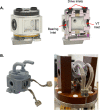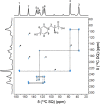One-Shot Resin 3D-Printed Stators for Low-Cost Fabrication of Magic-Angle Spinning NMR Probeheads
- PMID: 37376721
- PMCID: PMC10339279
- DOI: 10.1021/acs.analchem.3c01323
One-Shot Resin 3D-Printed Stators for Low-Cost Fabrication of Magic-Angle Spinning NMR Probeheads
Abstract
Additive manufacturing such as three-dimensional (3D)-printing has revolutionized the fast and low-cost fabrication of otherwise expensive NMR parts. High-resolution solid-state NMR spectroscopy demands rotating the sample at a specific angle (54.74°) inside a pneumatic turbine, which must be designed to achieve stable and high spinning speeds without mechanical friction. Moreover, instability of the sample rotation often leads to crashes, resulting in costly repairs. Producing these intricate parts requires traditional machining, which is time-consuming, costly, and relies on specialized labor. Herein, we show that 3D-printing can be used to fabricate the sample holder housing (stator) in one shot, while the radiofrequency (RF) solenoid was constructed using conventional materials available in electronics stores. The 3D-printed stator, equipped with a homemade RF coil, showed remarkable spinning stability, yielding high-quality NMR data. At a cost below 5 €, the 3D-printed stator represents a cost reduction of over 99% compared to repaired commercial stators, illustrating the potential of 3D-printing for mass-producing affordable magic-angle spinning stators.
Conflict of interest statement
The authors declare no competing financial interest.
Figures





References
-
- Werner M.; Rothermel N.; Breitzke H.; Gutmann T.; Buntkowsky G. Recent Advances in Solid State NMR of Small Molecules in Confinement. Isr. J. Chem. 2014, 54, 60–73. 10.1002/ijch.201300095. - DOI
-
- Li M.; Xu W.; Su Y. Solid-State NMR Spectroscopy in Pharmaceutical Sciences. TrAC Trends Anal. Chem. 2021, 135, 11615210.1016/j.trac.2020.116152. - DOI
-
- Martineau C.; Senker J.; Taulelle F.. NMR Crystallography, Webb, G. A. B. T.-A. R. on N. M. R. S., Ed; Academic Press, 2014; Vol. 82, pp 1–57.
LinkOut - more resources
Full Text Sources

